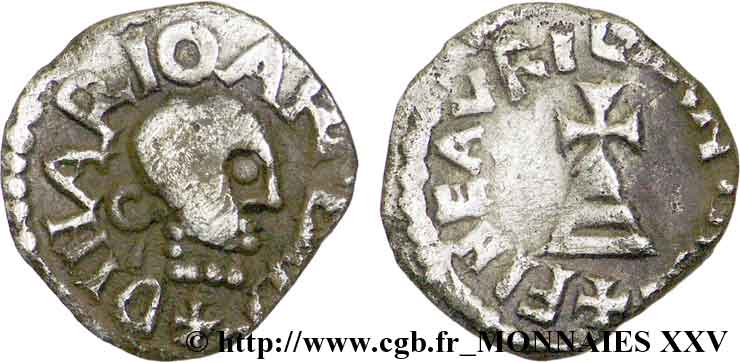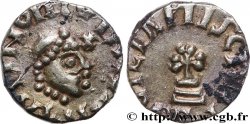v25_0805 - AURELIANORUM CIVITAS - ORLÉANS (Loiret) Denier
MONNAIES 25 (2006)
Starting price : 420.00 €
Estimate : 900.00 €
Realised price : 1 725.00 €
Number of bids : 14
Maximum bid : 2 008.00 €
Starting price : 420.00 €
Estimate : 900.00 €
Realised price : 1 725.00 €
Number of bids : 14
Maximum bid : 2 008.00 €
Type : Denier
Date: n.d.
Mint name / Town : Orléans
Metal : silver
Diameter : 12,00 mm
Orientation dies : 3 h.
Weight : 1,21 g.
Rarity : UNIQUE
Coments on the condition:
Denier frappé sur un flan large, mais irrégulier. Légendes presque complètes au droit comme au revers. Patine grise, surtout au droit et sur la partie droite du revers
Obverse
Obverse legend : +DINARIO AR(...).
Obverse description : Tête casquée à droite, le cou perlé ; légende autour ; grènetis.
Reverse
Reverse legend : + FINE AVRILIAN(...).
Reverse description : Croix posée sur trois degrés ; légende autour.
Commentary
Denier inédit, avec d’intéressantes légendes bien lisibles et elles aussi inédites.
Les légendes DINARIO AR(...) et FINE AVRILIAN(...) semblent complètement inédites ; elles manquent tant à l’index du Belfort que du Prou, ou encore du Moneta 22 “L’Âge du denier”. La légende DINARIO est connue uniquement sur un denier de Lyon (cf. Prou. n° 96, LVGDVNO DINARIOS). Le revers de ce denier attribué à Lyon est très proche du notre, mais avec une légende différente. La fin de la légende est partiellement hors flan, mais il semble probable que AR soit en rapport avec la nature du métal. Malgré le fait que cette monnaie soit inédite, l’attribution à Orléans semble probable en raison de la légende FINE AVRIL(...).
Les légendes DINARIO AR(...) et FINE AVRILIAN(...) semblent complètement inédites ; elles manquent tant à l’index du Belfort que du Prou, ou encore du Moneta 22 “L’Âge du denier”. La légende DINARIO est connue uniquement sur un denier de Lyon (cf. Prou. n° 96, LVGDVNO DINARIOS). Le revers de ce denier attribué à Lyon est très proche du notre, mais avec une légende différente. La fin de la légende est partiellement hors flan, mais il semble probable que AR soit en rapport avec la nature du métal. Malgré le fait que cette monnaie soit inédite, l’attribution à Orléans semble probable en raison de la légende FINE AVRIL(...).








 Report a mistake
Report a mistake Print the page
Print the page Share my selection
Share my selection Ask a question
Ask a question Consign / sell
Consign / sell
 Full data
Full data